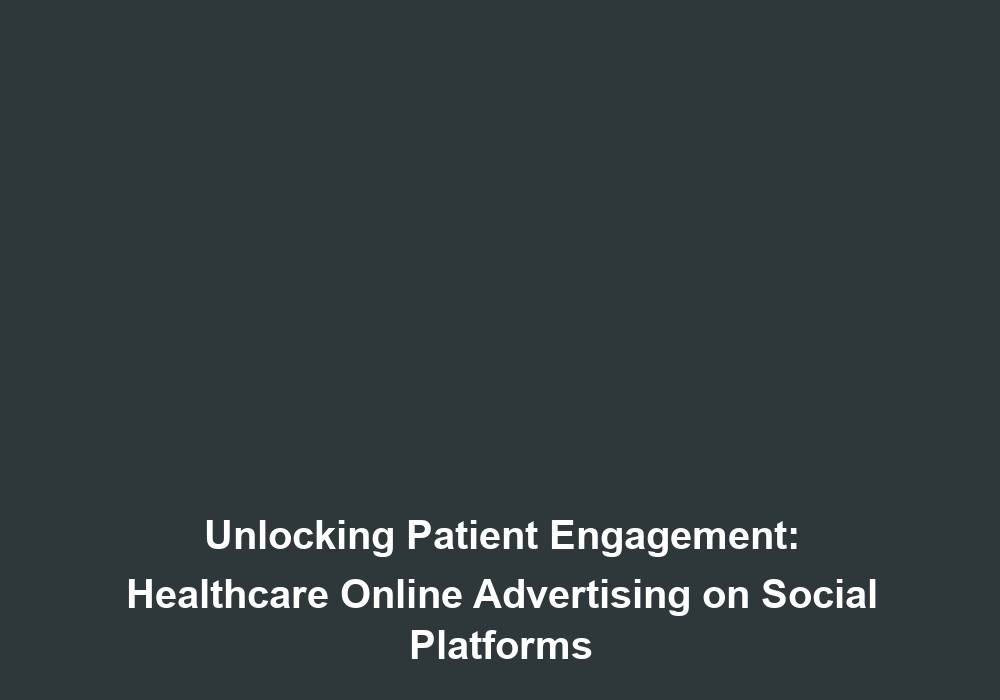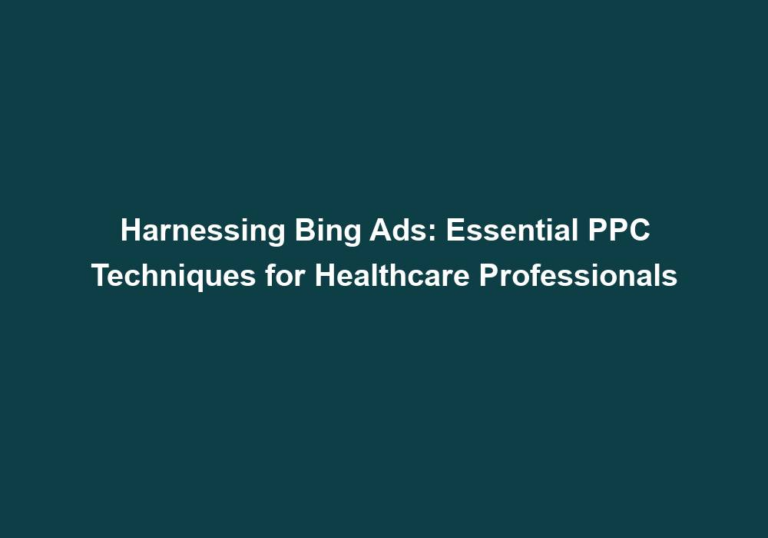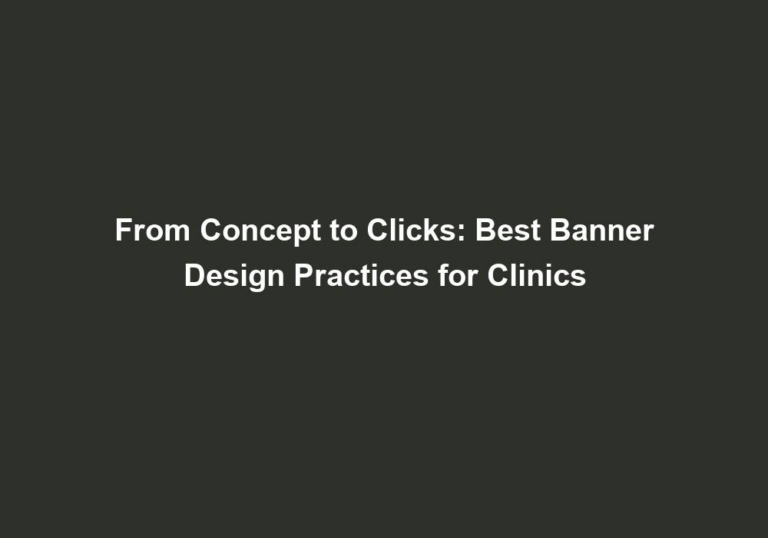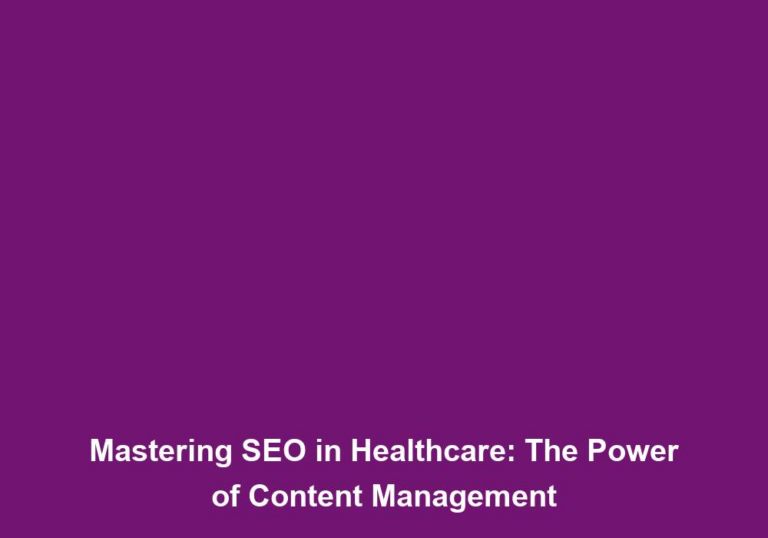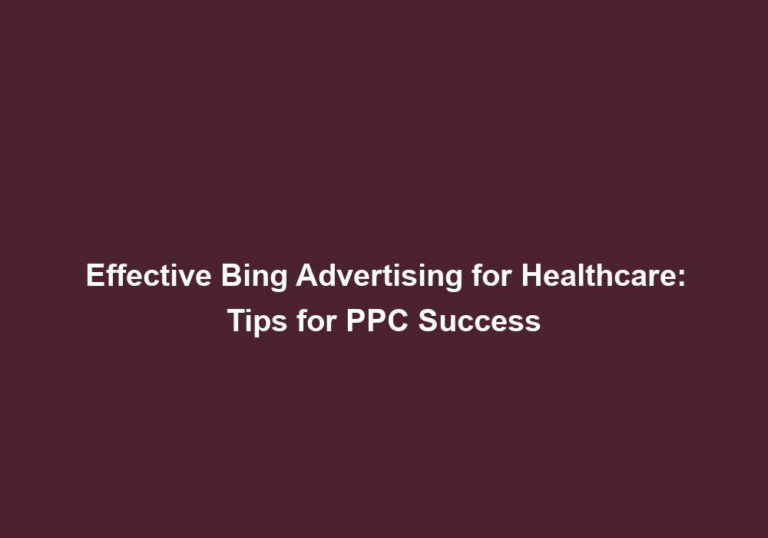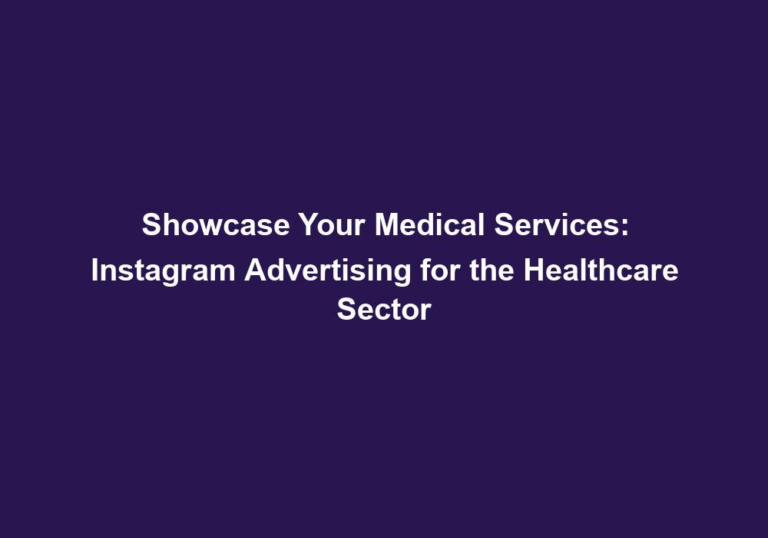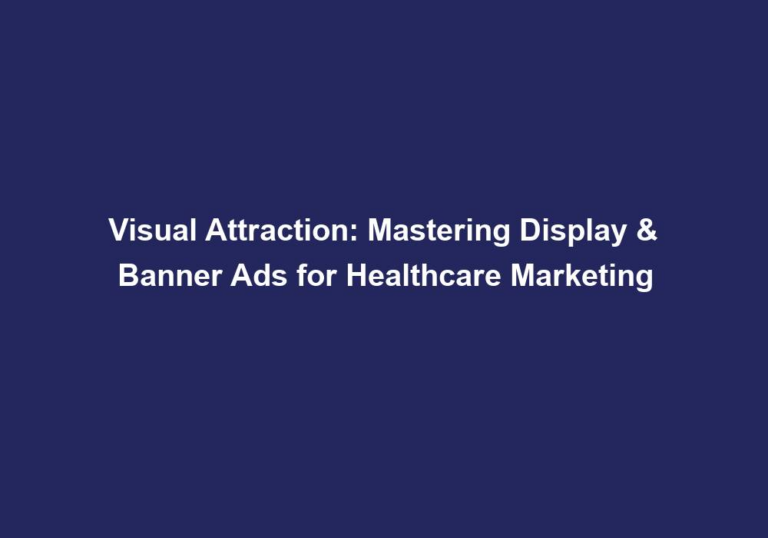Unlocking Patient Engagement: Healthcare Online Advertising on Social Platforms
In today’s digital age, online advertising is an essential tool for healthcare providers to reach their target audience and engage with patients effectively. With the increasing popularity of social media platforms, healthcare organizations have realized the immense potential they hold in connecting with patients and fostering meaningful relationships. This article will explore the strategies and best practices for healthcare online advertising on social platforms, aiming to unlock patient engagement and maximize the impact of digital marketing efforts.
The Power of Social Media in Healthcare Advertising
Social media platforms have revolutionized the way people connect, interact, and consume information. With billions of active users worldwide, platforms like Facebook, Instagram, Twitter, and LinkedIn offer healthcare providers a vast pool of potential patients to engage with. Here are some key reasons why social media is crucial for healthcare advertising:
-
Expanding Reach: Social media platforms allow healthcare organizations to extend their reach beyond traditional marketing channels and connect with patients on a global scale. By leveraging the power of hashtags, sharing relevant content, and engaging with users directly, healthcare providers can significantly increase their visibility.
-
Building Brand Awareness: Establishing a strong online presence is vital for healthcare organizations to build brand awareness and credibility. Social media platforms offer an opportunity to showcase expertise, share success stories, and educate patients about the services and solutions offered.
-
Targeted Advertising: Social media platforms provide robust targeting options, allowing healthcare organizations to reach specific demographics, interests, and behaviors. By tailoring advertisements to the desired audience, healthcare providers can ensure their messages resonate with those who are most likely to engage and convert.
-
Real-Time Interaction: Social media platforms enable healthcare providers to engage in real-time conversations with patients. This direct interaction allows for personalized communication, fostering trust, and building lasting relationships.
Expanding Reach
Expanding reach is a crucial aspect of healthcare online advertising on social platforms. Healthcare organizations can utilize various strategies to extend their reach and connect with a global audience:
-
Hashtag Strategy: Hashtags are powerful tools for increasing visibility on social media platforms. By using relevant and popular hashtags in their posts, healthcare organizations can reach a wider audience who are interested in specific topics or conditions. For example, a healthcare provider specializing in diabetes treatment can use hashtags like #diabetesawareness, #diabetesmanagement, or #diabetesprevention to attract individuals seeking information on diabetes-related topics.
-
Sharing Relevant Content: Sharing informative and engaging content is a great way to expand reach on social media. Healthcare organizations can create blog articles, infographics, videos, or podcasts that provide valuable information to their target audience. By sharing this content on social media platforms, they can attract users who are interested in the topic and increase their visibility among potential patients.
-
Engaging with Users: Actively engaging with users on social media is a powerful way to expand reach. Healthcare organizations can respond to comments, answer questions, and participate in discussions related to their field. By establishing a presence and engaging with users, they can attract more followers, increase their reach, and build a community of engaged patients.
Building Brand Awareness
Building brand awareness is essential for healthcare organizations to establish themselves as trusted sources of information and services. Here are some strategies to build brand awareness through healthcare online advertising on social platforms:
-
Showcasing Expertise: Social media platforms provide an opportunity to showcase expertise and establish credibility. Healthcare organizations can share content that highlights their knowledge and experience in their respective fields. This can include informative blog articles, case studies, white papers, or research findings. By demonstrating their expertise, healthcare providers can position themselves as authorities in their areas of specialization and build trust among their audience.
-
Sharing Success Stories: Sharing success stories of patients who have benefited from the healthcare organization’s services can be a powerful way to build brand awareness. These stories can inspire and resonate with potential patients, showcasing the positive impact the organization has had on people’s lives. Healthcare organizations can share testimonials, before-and-after stories, or interviews with satisfied patients to highlight their success in delivering quality care.
-
Educating Patients: Social media platforms offer a unique opportunity to educate patients about various health topics, conditions, and treatment options. Healthcare organizations can create informative content that addresses common questions or concerns, provides tips for maintaining good health, or explains the benefits of different treatment approaches. By sharing educational content, healthcare providers can position themselves as valuable sources of information and build trust with patients.
Targeted Advertising
Targeted advertising is a crucial aspect of healthcare online advertising on social platforms. By reaching specific demographics, interests, and behaviors, healthcare organizations can ensure that their advertisements resonate with the intended audience. Here are some strategies for effective targeted advertising:
-
Data Analytics: Utilizing data analytics can provide valuable insights into patient demographics, preferences, and behaviors. Healthcare organizations can analyze data from their website, social media platforms, or third-party sources to understand their target audience better. This information can be used to create targeted advertisements that align with the audience’s interests and needs.
-
Segmentation: Segmenting the target audience based on various criteria can help healthcare organizations tailor their advertisements effectively. For example, they can create different advertisements for different age groups, genders, or geographic locations. By understanding the unique needs and preferences of each segment, healthcare providers can create personalized advertisements that resonate with the intended audience.
-
Interest-Based Targeting: Social media platforms offer interest-based targeting options, allowing healthcare organizations to reach users who have shown interest in specific topics or activities. For example, a healthcare organization specializing in sports medicine can target users who follow sports-related accounts or have shown interest in fitness activities. By targeting users with relevant interests, healthcare providers can increase the chances of engaging with individuals who are more likely to be interested in their services.
Real-Time Interaction
Real-time interaction is a powerful feature of social media platforms that healthcare organizations can leverage to engage with patients effectively. Here are some strategies for real-time interaction:
-
Prompt Responses: Healthcare organizations should aim to respond promptly to comments, messages, or mentions on social media platforms. This shows that they value patient feedback and are actively listening to their concerns. By addressing queries or concerns in real-time, healthcare providers can build trust and demonstrate their commitment to patient satisfaction.
-
Personalized Communication: Social media platforms provide an opportunity for personalized communication with patients. Healthcare organizations can use direct messages or chat features to have one-on-one conversations with patients. This personalized communication helps foster trust and build lasting relationships, as patients feel valued and understood.
-
Live Q&A Sessions: Hosting live question-and-answer sessions on social media platforms can be an effective way to engage with patients in real-time. Healthcare organizations can invite patients to ask questions about specific topics or conditions and provide expert answers. This interactive approach allows for direct engagement and encourages patients to actively participate in the conversation.
Crafting Effective Social Media Advertisements
To unlock patient engagement through healthcare online advertising on social platforms, it is essential to adopt a strategic approach. The following guidelines will help healthcare organizations create compelling and effective social media advertisements:
1. Define Your Objectives
Before launching any advertising campaign, it is crucial to define clear objectives. Whether the goal is to generate leads, drive website traffic, increase brand awareness, or promote a specific service, having a well-defined objective will guide the entire campaign and allow for better measurement of success.
-
Lead Generation: If the objective is to generate leads, healthcare organizations can create advertisements that offer valuable resources in exchange for contact information. For example, they can offer free e-books, white papers, or webinars related to their services. By collecting contact information, healthcare providers can follow up with potential patients and nurture them through the sales funnel.
-
Website Traffic: If the goal is to drive website traffic, healthcare organizations can create advertisements that promote specific landing pages or blog articles. By providing a clear call-to-action and directing users to relevant content on their website, healthcare providers can increase engagement and encourage users to explore their offerings further.
-
Brand Awareness: To increase brand awareness, healthcare organizations can create advertisements that focus on showcasing their expertise, success stories, or unique selling propositions. These advertisements should be visually appealing and convey the brand’s values and mission effectively. By consistently exposing their target audience to their brand message, healthcare providers can establish brand recognition and recall.
2. Know Your Target Audience
Understanding the target audience is paramount when creating social media advertisements. Conducting market research and utilizing data analytics can provide valuable insights into patient demographics, preferences, and behaviors. Such knowledge helps tailor advertisements to resonate with the intended audience, yielding higher engagement rates.
-
Demographic Research: Healthcare organizations should gather demographic data about their target audience, including age, gender, location, and occupation. This information helps in creating advertisements that speak directly to the target audience’s needs and interests.
-
Psychographic Research: Psychographic research involves understanding the target audience’s personality traits, values, interests, and lifestyle choices. Healthcare organizations can use this information to create advertisements that align with the audience’s preferences and resonate with their emotional and psychological needs.
-
Behavioral Research: Behavioral research focuses on understanding the target audience’s online behavior, such as their social media usage patterns, content consumption habits, and purchasing behaviors. This information helps healthcare organizations deliver advertisements at the right time and in the right format to maximize engagement and conversion rates.
3. Compelling Visual Content
Visual content is key to capturing users’ attention in the fast-paced world of social media. High-quality images, videos, and graphics can significantly enhance the effectiveness of advertisements. Attention-grabbing visuals should be combined with concise and compelling copy to convey the intended message efficiently.
-
High-Quality Images: Healthcare organizations should use high-quality images that are visually appealing and relevant to the advertisement’s message. Images should be clear, well-lit, and professionally shot to create a positive impression and grab users’ attention.
-
Engaging Videos: Videos are highly engaging and can effectively convey complex information or tell compelling stories. Healthcare organizations can create videos that showcase their facilities, introduce their team members, or provide educational content. Videos should be concise, visually appealing, and optimized for social media platforms.
-
Eye-Catching Graphics: Graphics, such as infographics or illustrations, can be used to present information in a visually appealing and easy-to-understand format. Healthcare organizations can create graphics that highlight key statistics, explain medical procedures, or demonstrate the benefits of their services. Graphics should be visually striking, well-designed, and optimized for social media platforms.
4. Emphasize Value and Benefits
To engage patients effectively, healthcare advertisements should focus on the value and benefits of the services or solutions offered. Highlighting how the healthcare organization can improve patients’ lives, address their pain points, or provide unique solutions helps establish trust and encourages engagement.
-
Identify Pain Points: Healthcare organizations should identify the pain points or challenges that their target audience faces. This can be done through market research, patient surveys, or analyzing common complaints or inquiries. By understanding the audience’s pain points, healthcare providers can create advertisements that directly address these issues and position their services as solutions.
-
Highlight Unique Selling Propositions: Healthcare organizations should emphasize their unique selling propositions (USPs) in their advertisements. USPs are the qualities or features that set the organization apart from competitors. Whether it’s cutting-edge technology, specialized expertise, or a patient-centric approach, these USPs should be prominently highlighted to attract the target audience’s attention and differentiate the healthcare organization from others.
-
Showcase Testimonials and Reviews: Including testimonials and reviews from satisfied patients in advertisements can be a powerful way to emphasize the value and benefits of the healthcare organization’s services. Positive feedback and personal stories help build trust and credibility, as potential patients can see real-life examples of how the organization has positively impacted others.
5. Utilize Call-to-Action (CTA)
Including a clear and compelling call-to-action in social media advertisements is crucial to driving patient engagement. A well-crafted CTA prompts users to take specific actions, such as booking an appointment, downloading an e-book, or signing up for a newsletter. CTAs should be concise, action-oriented, and prominently displayed to maximize conversion rates.
-
Clear and Concise Language: CTAs should use clear, concise language that communicates the desired action to the audience. For example, instead of using vague language like “Learn More,” a healthcare organization can use a specific CTA like “Book Your Appointment Now” or “Download Your Free Guide.”
-
Prominent Placement: CTAs should be prominently placed within the advertisement to ensure they catch the user’s attention. They can be placed at the beginning, middle, or end of the advertisement, depending on the desired impact. Using contrasting colors or design elements can also help draw attention to the CTA.
-
Sense of Urgency: Creating a sense of urgency in the CTA can motivate users to

